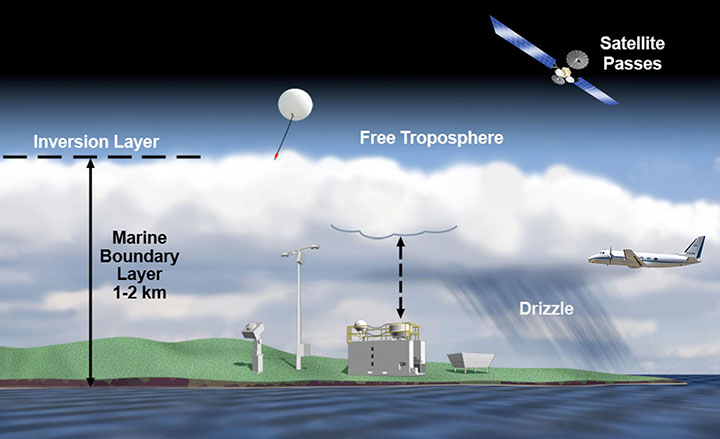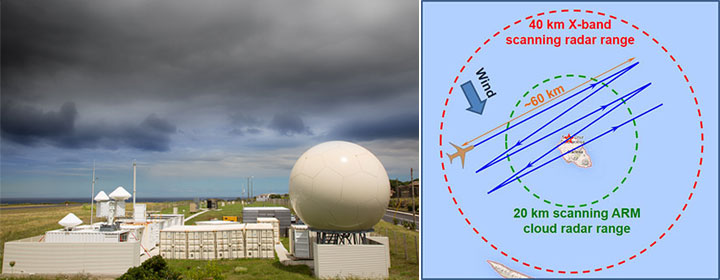Scientists Launch Flights to Gather Detailed Data on Aerosols and Clouds
Study over Eastern North Atlantic aims to clear up understanding of how aerosols affect low marine clouds and improve assessments of their impact on Earth¹s climate
May 8, 2017
 enlarge
enlarge
Using an aircraft outfitted with 55 atmospheric instrument systems, scientists will traverse horizontal tracks above and through clouds and spiral down through atmospheric layers to provide detailed, on-site measurements of aerosols and cloud properties. The data will supplement measurements made by ground-based radars and other instruments to provide a more complete understanding of how aerosol properties affect low marine boundary layer clouds, and help improve the representations of clouds and aerosols in models of Earth's climate.
“Low level clouds are abundant and can have a big influence on global climate by affecting how much solar energy is reflected back into space,” said Jian Wang, an atmospheric scientist at DOE’s Brookhaven National Laboratory and lead researcher on the study. “One of the biggest uncertainties in Earth system models is our understanding of how clouds respond to changes in the properties of aerosols, tiny particles wafted into the atmosphere as salty sea spray or emitted from distant industrial sources.”
 enlarge
enlarge
A large fraction of the computer-choreographed flight tracks for the study will cross within the ranges of the ground-based scanning radars at DOE's Atmospheric Radiation Measurement (ARM) Climate Research Facility on Graciosa Island in the Azores (photo).
The new study will supplement the year-round, ground-based dataset with a series of airborne sampling missions—approximately 20 in the summer and 20 in the winter—flown aboard ARM’s Gulfstream-159 (G-1) research aircraft. The G-1 is the centerpiece of the ARM Aerial Facility managed by DOE’s Pacific Northwest National Laboratory (PNNL). For this study it will be outfitted with 55 atmospheric instrument systems that will provide detailed “on-site” measures of the physical and chemical properties of aerosols and cloud particles, including variations in their distribution throughout the horizontal and vertical structure of the clouds.
 enlarge
enlarge
Brookhaven Lab atmospheric scientist Jian Wang is the principal investigator for the aerosol and cloud study campaign in the Eastern North Atlantic.
On some flights, the scientists will also sample the free troposphere, high above the boundary layer clouds. Data collected there will help determine whether the observed aerosol particles are coming from local sources or being transported long distances.
The G-1 will take off from a joint U.S.-Portugal airbase 90 kilometers from Graciosa, with a large fraction of the computer-choreographed flight tracks crossing within the ranges of the ground-based scanning radars. Flying within range of the radars will allow scientists to use the detailed microphysical information obtained from the aircraft flights to evaluate, validate, and improve how they interpret the ground-based data.
Collaborators will also bring samples of aerosol particles collected during the flights to PNNL’s Environmental Molecular Sciences Laboratory and Lawrence Berkeley National Laboratory’s Advanced Light Source—both DOE Office of Science User Facilities—for subsequent analysis.
 enlarge
enlarge
The Gulfstream-159 (G-1) research aircraft—centerpiece of the ARM Aerial Facility managed by DOE's Pacific Northwest National Laboratory—ready for takeoff.
The ARM Climate Research Facility is a DOE Office of Science User Facility. The ARM Facility is operated by nine DOE national laboratories.
Brookhaven National Laboratory is supported by the Office of Science of the U.S. Department of Energy. The Office of Science is the single largest supporter of basic research in the physical sciences in the United States, and is working to address some of the most pressing challenges of our time. For more information, please visit science.energy.gov.
2017-12138 | INT/EXT | Newsroom









